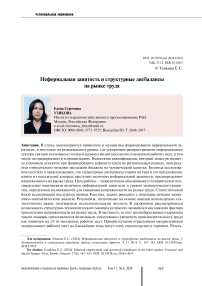Informal employment and structural imbalances in the labor market
Автор: Uzyakova E.S.
Журнал: Economic and Social Changes: Facts, Trends, Forecast @volnc-esc-en
Рубрика: Regional economy
Статья в выпуске: 6 т.17, 2024 года.
Бесплатный доступ
The paper analyzes principles and mechanisms related to the development of informal employment, including at the regional level, where the accelerated growth of the informal sector is mainly caused by low living standards and lack of jobs, including in enterprises and organizations. The lack of skills, which is often a key aspect in the formation of labor shortages in regional markets, is mediated by relatively low budget expenditures on human capital. The hypothesis of the study is that structural imbalances in the demand for labor and its supply, one of the indicators of which is the extent of informal employment, determine the tension in the labor market. The aim of the work is to theoretically substantiate and empirically confirm the relationship between the extent of informal employment and the level of economic development, and to identify opportunities to reduce tension in the labor market. Statistical basis of the study includes Rosstat data; research tasks were solved using economic and mathematical analysis methods. The results obtained by analyzing statistical series confirmed the research hypothesis. In conclusion, we consider the possibility of structural and technological maneuver in economic sectors as an important factor in overcoming tension in the labor market. In particular, due to the labor-saving nature of such a maneuver, it is possible to significantly increase labor productivity by at least 15 million jobs. Construction and trade may become priority industry areas for workplace modernization in the coming years. The results of our calculations are considered as a preliminary assessment of the possibilities of labor productivity growth at the macro level, involving the development of special sectoral and regional programs to increase labor productivity, which is the practical significance of the results obtained.
Informal employment, hidden employment, labor productivity, population incomes, labor remuneration, qualifications, regional labor markets, labor market tension, structural and technological maneuver
Короткий адрес: https://sciup.org/147247141
IDR: 147247141 | УДК: 331.5 | DOI: 10.15838/esc.2024.6.96.9
Список литературы Informal employment and structural imbalances in the labor market
- Chen Y., Xu Z. (2017). Informal employment and China’s economic development. The Chinese Economy, 50(6), 425–433. DOI: 10.1080/10971475.2017.1380115
- Gërxhani K. (2004). The informal sector in developed and less developed countries: A literature survey. Public Choice, 120(3–4), 267–300.
- Gimpelson V.E., Kapeliushnikov R.I. (2012). Normal’no li byt’ neformal’nym? [Is It Normal to Be Informal?]. Working paper WP3/2012/09, Moscow: HSE Publishing House.
- Gimpelson V.E., Kapeliushnikov R.I. (Eds). (2014). V teni regulirovaniya: neformal’nost’ na rossiiskom rynke truda [In the Shadow of Regulation: Informality in the Russian Labour Market]. Moscow: HSE Publishing House.
- Hart K. (1973). Informal income opportunities and urban employment in Ghana. The Journal of Modern African Studies, 11(1), 61–89.
- Klepach A.N. (2021). Social and technological challenges of the Russian economy. Nauchnye trudy Vol’nogo ekonomicheskogo obshchestva Rossii=Scientific Works of the Free Economic Society of Russia, 230(4), 103–112. DOI: 10.38197/2072-2060-2021-230-4-103-112 (in Russian).
- Korovkin A.G., Dolgova I.N., Korolev I.B. (2010). The analysis and modeling of the interrelated labor market and education system dynamics in the Russian economy. In: Korovkin A.G. (Ed.). Nauchnye trudy: In-t narodnokhozyaistvennogo prognozirovaniya RAN [Scientific Articles – Institute of Economic Forecasting Russian Academy of Sciences]. Moscow: MAKS Press.
- Korovkin A.G., Dolgova I.N., Korolev I.B. (2016). Labor demand and supply adjustment taking into account educational characteristics: Regional aspect. In: Korovkin A.G. (Ed.). Nauchnye trudy: In-t narodnokhozyaistvennogo prognozirovaniya RAN [Scientific Articles – Institute of Economic Forecasting Russian Academy of Sciences]. Moscow: MAKS Press.
- Kunitsyna N.N., Dzhioev A.V. (2023). Dependence of informal employment on population income in Russian regions: Lessons from the pandemic. Ekonomika regiona=Economy of Regions, 19(2), 437–450. DOI: https://doi.org/10.17059/ekon.reg.2023-2-11 (in Russian).
- Mikheeva N.N. (2021). Prostranstvennye aspekty razrabotki ekonomicheskikh prognozov: nauchnyi doklad [Spatial Aspects of the Development of Economic Forecasts]. Moscow: Artique Print.
- Nekipelova D.V. (2019). Informal employment in Russia: Causes and socio-economic consequences. Gipoteza=Hypothesis, 4(9) (in Russian).
- Roncolato L., Kucera D. (2014) Structural drivers of productivity and employment growth: A decomposition analysis for 81 countries. Cambridge Journal of Economics, 38(2), 399–424.
- Salin V.N., Narbut V.V. (2017). Informal employment of the population of Russia: Assessment of the scale and the impact on public finance of the country. Finansy: teoriya i praktika=Finance: Theory and Practice, 21(6), 60–69. DOI: https://doi.org/10.26794/2587-5671-2017-21-6-60-69 (in Russian).
- Sim W.J., Huam H.T., Rasli A., Lee T.C. (2011). Underground economy: Definition and causes. Business and Management Review, 1(2), 14–24.
- Solow R. (1956). A contribution to the theory of economic growth. Quarterly Journal of Economics, 70, 65–94.
- Solow R. (1957). Technical change and the aggregate production function. Review of Economics and Statistics, 39, 312–320.
- Soto E. (1995). Inoĭ put’. Nevidimaya revolyutsiya v Tret’em mire [The Other Path: The Invisible Revolution in the Third World]. Moscow: Catallaxy.
- Suvorov A.V., Suvorov N.V., Grebennikov V.G. et al. (2014). Approaches to measuring the dynamics and structure of human capital and assessing its accumulated impact on economic growth. Problemy prognozirovaniya=Studies on Russian Economic Development, 3, 3–17 (in Russian).
- Tumunbayarova Zh.B., Antsiferova M.D. (2018). Informal employment: Causes and determinants of its level. Tenevaya ekonomika=Shadow Economy, 2(4), 139–149. DOI: 10.18334/tek.2.4.40935 (in Russian).
- Uzyakova E.S. (2022). Informal employment and its impact on population’s income and labor productivity. Problemy prognozirovaniya=Studies on Russian Economic Development, 6(195), 198–207. DOI: 10.47711/0868-6351-195-198-207 (in Russian).
- Uzyakova E.S., Shirov A.A. (2024). Employment and labor productivity in Russia: Analysis and forecasts. Problemy prognozirovaniya=Studies on Russian Economic Development, 4(205), 6–20. DOI: 10.47711/0868-6351-205-6-20 (in Russian).
- Voicu С. (2012). Economics and “underground” economy theory. Theoretical and Applied Economics, XIX, 7(572), 71–84.


